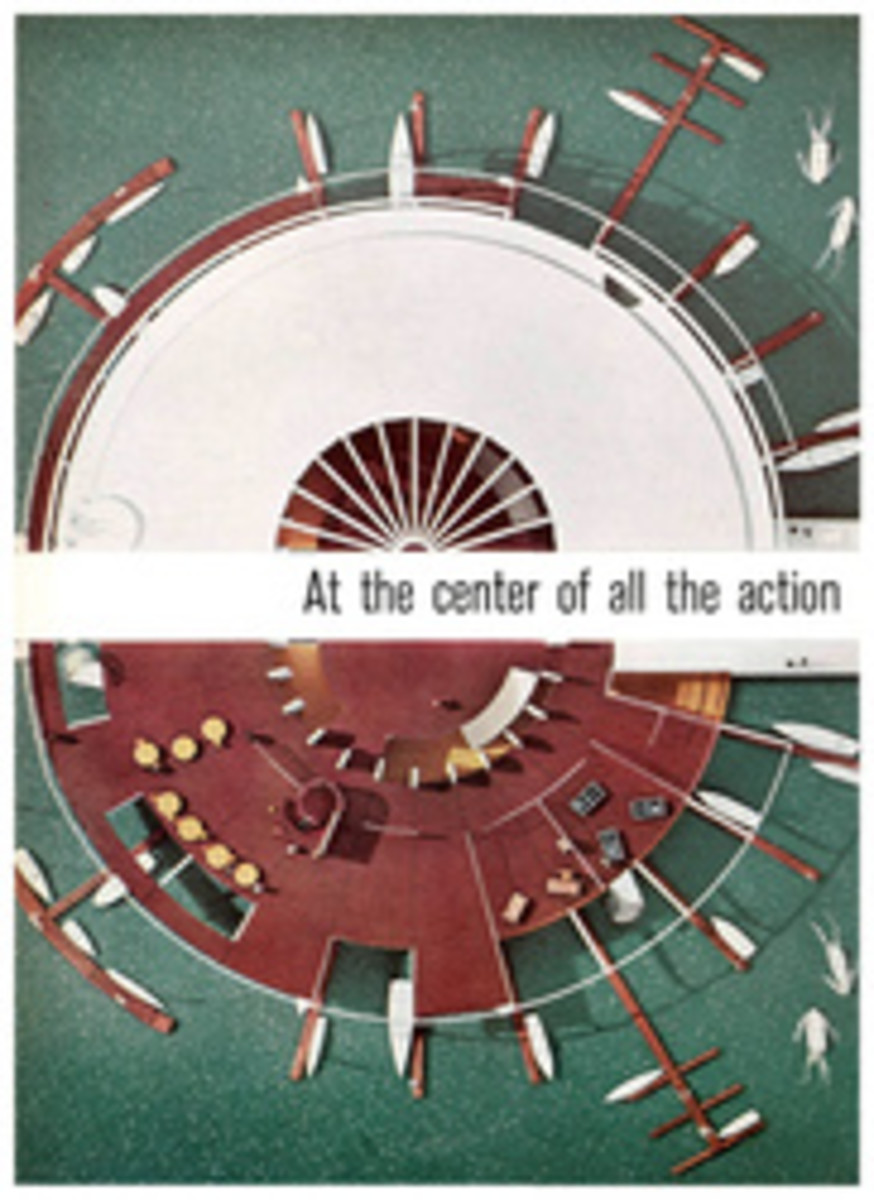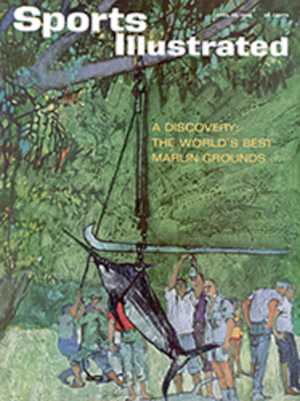
April 1923: First Day at Yankee Stadium
Forty years ago this spring—on Wednesday, April 18, 1923—I sat in the stands at the Yankee Stadium and saw the first game ever played there. It was a great day, this double opening of the Stadium and the season. It was the biggest one-day show baseball had ever staged, including World Series games. The Yankee tradition of bigness and power began, perhaps, right there that afternoon. Everything was big. The game (against the no-account Red Sox) drew the largest crowd in baseball history—74,200, the papers said the next day. The Stadium was the biggest, grandest and tallest baseball park in the world and the most costly ($2,500,000), and on the field in his brand-new white-and-pin-striped uniform was Babe Ruth, the game's biggest star. Tall, broad-shouldered and flat-bellied—it was before he became heavy and pear-shaped—the Babe swung a 52-ounce bat, said to be the biggest one in baseball, and handled it like a wand.
The Yankees put on a good show before the game started. Governor Al Smith threw out the first ball, a surprisingly fast one, which plopped right in the center of Catcher Wally Schang's mitt, and drew tumultuous cheers. There were at least two bands, one of which was directed by John Philip Sousa. There were floral wreaths all over the infield and a lot of handshaking by the opposing managers, Miller Huggins and Frank Chance; by the white-thatched baseball commissioner, Judge Kenesaw Mountain Landis; and the two chunky colonels who were co-owners of the Yankees, Colonel Jacob Ruppert and Colonel T. L. Huston.
It was big-league stuff, all of it: the overwhelming crowd, the triple-deck Stadium, the bands, Sousa, the governor, the Babe. It outclassed the Dodgers' opening the day before. In Ebbets Field they had drawn barely 14,000, and the man who tossed out the ball was someone named John F. Tanguey, who was the Exalted Ruler of the Brooklyn Elks. Big deal.
I was in my sophomore year at Yale and very close to probation in marks. Taking a Wednesday off meant cutting three classes and a lot of work that would have to be made up. It also meant the end of my cut allowance for the year. Worse yet, though, would be my skipping the track workout on Wednesday afternoon.
I ran the hurdles and had a good chance to make the combined Yale-Harvard team that would be sent to England that summer to run against Oxford-Cambridge. There were time trials scheduled for Wednesday, and if I didn't show up Johnny Mack would want to know why. He was our coach, a hard-bitten oldtime professional sprinter, and he took no nonsense from anyone. If he had ever found out that I had skipped track for a ball game, he would have thrown my track shoes into New Haven Harbor and me after them.
But I wanted to see that opener more than anything. Track was all right. It was great to break a tape with everybody behind you, but it wasn't a game—like baseball. You ran your race, got dressed, and that was that. I used to walk across the field and watch the ball game when I was through, but maybe that was only because my older brother played first base for Yale. Our father had once owned the Waterbury, Conn. ball club of the old Eastern Association. We were brought up on the game and always loved it.
Bill Comins, our crack broad jumper and sprinter, helped me work the dodge that got me out of the track workout. It was easy. I faked a pulled muscle after taking a couple of hurdles at Tuesday's practice and limped off the track. Comins grabbed me and supported me on the way to the field house. Johnny Mack came in while the trainer was taping me up and told me not to come out for a few days. I limped back to my room and tried to remember to keep limping until I was out of New Haven.
The next morning I joined the bunch going down to the game on the 11:30 train. There were five of us and we all carried books, supposedly to read in preparation for next day's classes, but nobody opened one. We talked about Ruth and how badly he had fallen off last season—from 59 homers and a batting average of .378 to 35 homers and .315 in one year—and how awful he had looked last fall in the World Series against the Giants, when he hit only .118 and the Yankees didn't win a game. The talk was that he was boozing it up a lot and couldn't be managed, and maybe he was through.
Some newspapers had said that the Babe was penitent and knew he was on trial this season. He was in shape and was going to stage a comeback. Ruth himself had said that he would give a year of his life if he could hit a home run in his first game in the new Yankee Stadium.
Major league games started at 3:30 in those days and we had almost two hours to spare when we got into the 125th Street Station and took a cab to the Stadium. It was a Checker cab, a square-top, boxlike affair that would seem odd today, but there was plenty of headroom inside and you could get into it without being a contortionist. It got us there all right, but none too soon.
There was an enormous crowd milling around the Stadium and nobody seemed to know where to go or what to do. Some of the ticket booths were already closed. There were no more boxes or reserved seats on sale—only seats in the grandstand and the bleachers.
While we were waiting in a long line at one of the booths a man walked by waving a fistful of grandstand tickets. He was hawking them for $1.25 apiece, a 15¢ boost over the box office price of $1.10. We were about to take a batch to save time, when a detective hustled him off.
All the seats were gone in the two lower tiers, and it must have taken us half an hour to reach the top one and get settled, far out in right field a mile from the plate. The players on the infield were tiny, about a third the size they looked from the upper stands in the Polo Grounds.
One good thing about being way up there was that the Old Man would never spot me. I knew that he would be at the game—that was another risk I'd considered—and I would just as soon have run into Johnny Mack as him. He was almost sure to be in a field box, probably sitting with his friend, Harry Frazee, who owned the Red Sox and who, incidentally, had wrecked his club by selling all his stars to the Yankees, Ruth among them.
When the Yankees took the field their shortstop, Deacon Scott, the Iron Man, got a good hand for starting his 987th consecutive game despite a lame leg that was supposed to keep him on the bench. It was a record number of straight games for any player at that time, and the Deacon held the mark until Lou Gehrig topped him years later. The Babe, of course, got his share of applause, and he responded by waving to the crowd as he trotted out to right field in those short, quick steps of his.
Umpire Tom Connolly behind the plate called "Play ball!" Bob Shawkey wound up and threw the first pitch in the new Stadium to the Red Sox leadoff man, Chick Fewster. It was a ball.
Nothing happened in the first inning. When Ruth trotted in toward the Yankee dugout, which was then on the third base side, he stepped squarely on second base as he crossed it. This gesture of always touching second on his way to the dugout became a superstition with him.
Howard Ehmke, the Red Sox pitcher, put the Yankees down in order in the first two innings, but in the third they began to reach him. A single, a sacrifice, a walk and another single accounted for the Yankees' first run and when the Babe came to bat there were two men on base and two out. He had flied out in the first when the bases were empty, but this was different. A showman to the core, Ruth was almost always at his best in a situation like this, and everyone in the park knew it and felt it.
The Babe worked the count up to two and two and then Ehmke fed him one of those slow balls that the Giants had murdered him with in the last World Series. It came in a little high and he went for it. The ball streaked over the infield on a line and kept on going, hardly rising at all, it seemed, and landed in the right field bleachers.
I doubt if there was anyone in the Stadium who wasn't on his feet as the Babe, beaming, trotted around the bases behind Whitey Witt and Joe Dugan. Rounding third, he took off his cap and, holding it at arm's length, waved it to the crowd all the way home. No shy tip of the cap from the Babe!
The Yankees did not score again and the game ended in their favor, 4-1. Ruth's three-run homer made the difference. Bob Shawkey went all the way, and so did his eight teammates.
Going back on the train that night, the books remained unopened, and again the talk was about Ruth, the Stadium and how the Yankees were on their way now and how about the Giants?
You didn't have to be very old to know the Yankee's history. Only 11 years before, their home was a small park in Washington Heights with an antiquated wooden stand. They were called the Highlanders and they were the joke of the American League. They came into the Polo Grounds in 1913 and played there for 10 years, sharing it as tenants with the Giants. John McGraw, the Giants' manager and a confirmed American League hater, had them booted out after Ruth's arrival when they began to outdraw his own club on his own grounds. He was certain that the Yankees could not find space to build a ball park in Manhattan and that they would die on the vine in any other borough—in the Bronx, for instance. "The fans will soon forget about them over there," he said.
No worse guess has ever been made in baseball annals. As every fan knows, it was the Giants who withered away and the Yankees who became the most successful club in baseball history. No one could see that far 40 years ago, least of all five college students who, as the train reached the outskirts of New Haven, were still enraptured by the performance of the great Yankee slugger.
PHOTO
THE CROWD GATHERED EARLY FOR THE HISTORIC OPENING, THE MORE PROSPEROUS FANS IN CARS OF THE VERY LATEST MODEL
PHOTO
THE BABE PLAYED UP TO THE OCCASION
PHOTO
GOVERNOR AL SMITH (LOWER RIGHT FOREGROUND) THREW OUT THE FIRST BALL
PHOTO
AMONG THE VIPS were (left to right) New York Manager Miller Huggins, Yankee Co-owner Colonel Jake Ruppert and Boston Manager Frank Chance.

